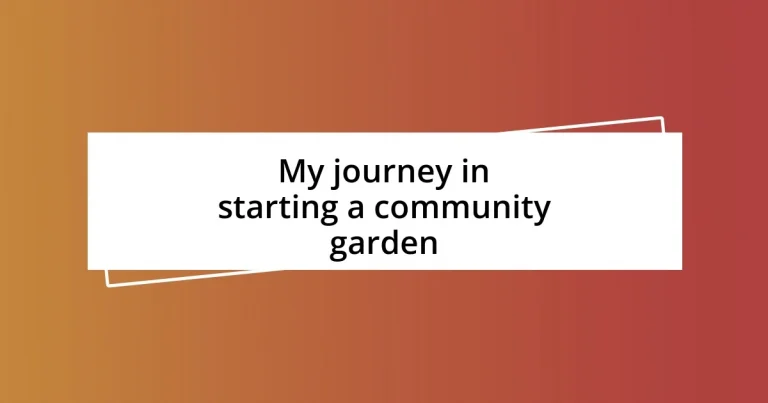Key takeaways:
- Community gardens foster connections among neighbors, enhancing social ties and promoting a sense of ownership and accountability for food security.
- Choosing the right location and involving the community through meetings and inclusivity are crucial steps in starting and maintaining a successful garden.
- Celebrating achievements, such as harvest festivals and donations to food banks, strengthens community bonds and highlights the garden’s role in nurturing both relationships and the environment.

Understanding community gardens importance
Community gardens hold a special place in our neighborhoods, serving as vibrant spaces for connection and collaboration. I still remember the first time I dug into the soil of my local garden, surrounded by strangers who quickly became friends. Isn’t it incredible how a patch of earth can transform people, fostering friendships that might not have blossomed otherwise?
Moreover, these gardens contribute significantly to food security. When I planted those first tomatoes with my neighbors, we were not just growing produce; we were cultivating a sense of ownership and accountability for our community’s health. Have you ever considered how empowering it is to harvest fresh vegetables knowing you played a role in their growth? It’s a direct connection to our food sources that many of us often overlook.
Finally, the environmental benefits of community gardens are remarkable. They serve as little oases for pollinators and a variety of insects. I’ve seen bees buzzing around our blooms, and each time I do, I can’t help but feel hopeful for the environment. Isn’t it amazing how small actions in our gardens can contribute to the larger tapestry of nature? It’s a reminder that we all have a part to play in nurturing the planet.
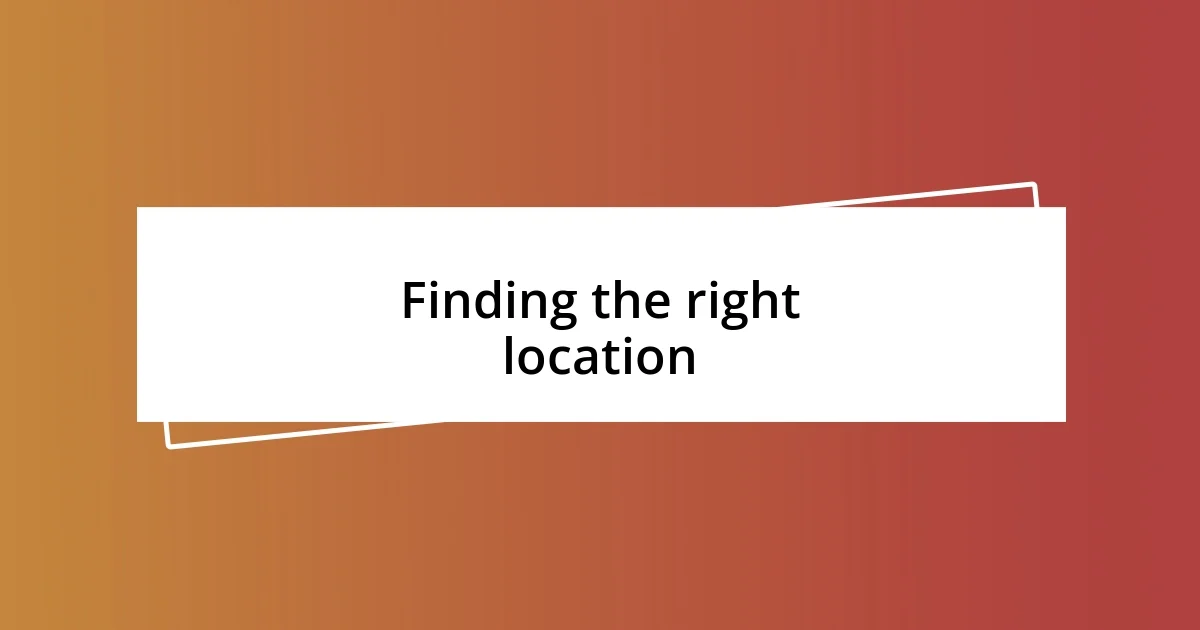
Finding the right location
Finding the right location for a community garden is truly a critical step. I recall our first meeting when someone suggested an abandoned lot down the street. At first, I was skeptical—why choose a place that seemed overlooked? However, as we gathered to discuss it, I began to see the potential; it was close to the community; everyone could see it, and that alone sparked excitement.
When scouting for the ideal spot, consider these essential factors:
– Sunlight: Ensure the area gets at least 6-8 hours of direct sunlight daily for optimal plant growth.
– Accessibility: The location should be easy to reach by foot or public transport, encouraging more community members to participate.
– Soil Quality: Test the soil for contaminants and nutrient levels; healthy soil is the foundation of any flourishing garden.
– Water Source: Proximity to a water supply saves time and effort when it comes to irrigation.
– Community Interest: Gauge interest from neighbors; a passionate group can turn any space into a lively garden.
Each of these factors played a role in our final choice, making the journey exhilarating and collaborative. With the right location, our little garden began to feel like not just a plot of land, but a heartbeat for our neighborhood.
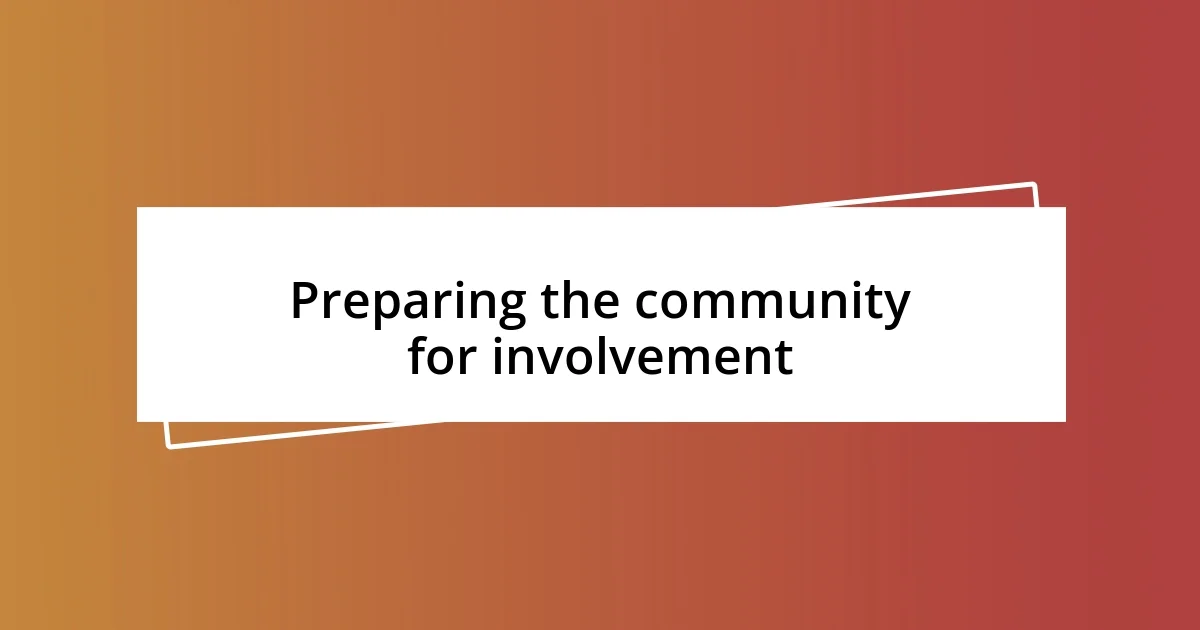
Preparing the community for involvement
Preparing the community for involvement requires a thoughtful approach. I found that the best way to start was by hosting an informal meeting. I’ll never forget the energy in the room when I shared my vision for the garden. People nodded along, their eyes bright with curiosity. It made me realize that when you spark interest, community members are more likely to come together and contribute their ideas.
One effective strategy we used was to create a flyer that highlighted the benefits of the garden. I personally wrote it, explaining how the garden could enhance our neighborhood’s beauty and provide fresh produce. I also invited folks to share their gardening experiences, which opened up discussions. Sharing stories was surprisingly powerful; suddenly, everyone wanted to pitch in, whether it was donating seeds, volunteering for cleanup days, or simply spreading the word.
As we moved forward, I discovered the importance of inclusivity. We encouraged everyone, regardless of gardening experience, to join us. This invitation felt like a warm embrace; I watched shy neighbors slowly open up as we worked side by side. It’s amazing how a simple “Let’s grow together” can transform a community.
| Preparation Strategy | Outcome |
|---|---|
| Host an Informal Meeting | Gathered interest and excitement |
| Create Engaging Flyers | Encouraged sharing and ownership of the project |
| Promote Inclusivity | Strengthened community bonds and participation |

Designing the garden layout
Designing the layout of our community garden felt like piecing together a giant puzzle. I remember walking through the lot with a notebook, sketching out ideas as we all brainstormed. Should we have raised beds or traditional rows? Everyone had different opinions, and it was exciting to see how those discussions sparked creativity. After all, isn’t the beauty of a community garden the way it reflects the diversity of its contributors?
As we plotted out the garden, we had to consider practical aspects too. I’ll never forget the day we decided to include a pathway that would weave through the plants. It wasn’t just about aesthetics; we wanted to invite people to stroll, to linger, and to connect. I chuckled when one neighbor suggested we add signs with plant names, saying, “Let’s turn it into a learning garden too!” It was such a simple idea, but it enhanced our mission to educate and inspire each other.
Reflecting on our layout choices, I realized how every decision shaped the garden’s atmosphere. We included a small seating area where families could gather, and I found myself daydreaming about weekend picnics amid herbs and vegetables. How often do we get the chance to create not just a garden, but a gathering space? Each element of the design wasn’t just about functionality; it became a canvas for memories waiting to bloom.
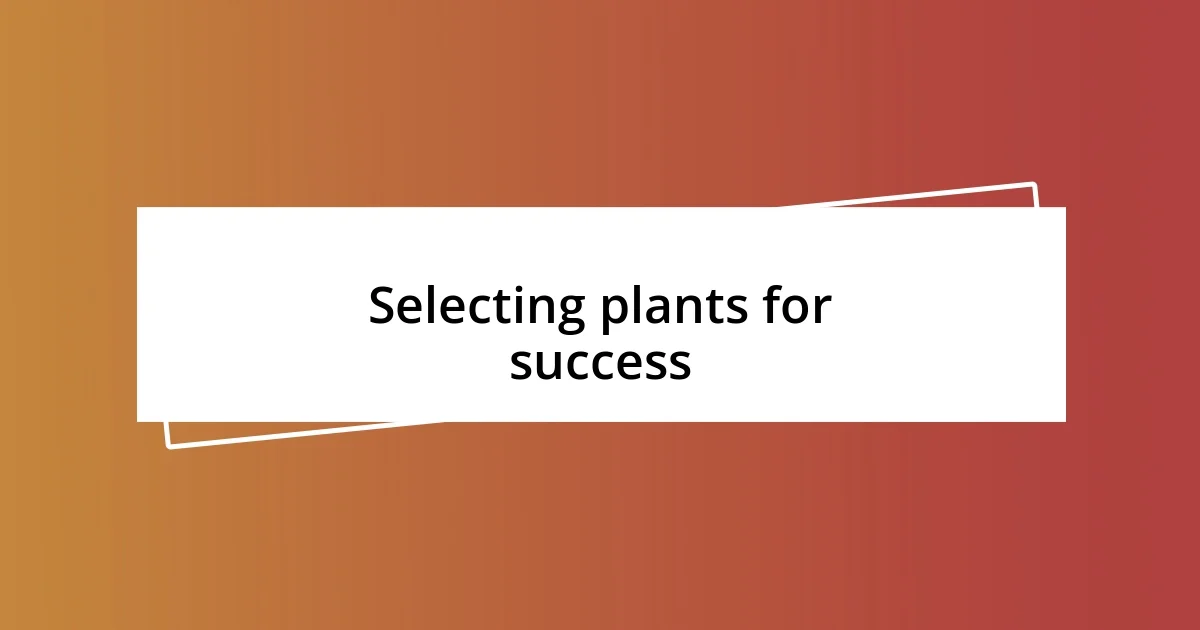
Selecting plants for success
Choosing the right plants for our community garden was both exciting and a bit daunting. I vividly remember diving into local gardening guides, eager to uncover which plants would thrive in our specific climate. It struck me how important it is to prioritize the needs of the plants—would they flourish in our sun-soaked plot or curl up in the shade? I’ve learned that considering these factors can make or break the success of our garden.
I also discovered the joy of selecting plants that the community truly wanted. One afternoon, we held a lively brainstorming session where everyone shared their favorite vegetables and flowers. As I listened, I felt a thrill at the thought of growing colorful tomatoes and zinnias, which would not only beautify our space but also tantalize taste buds. Isn’t it amazing how shared preferences can influence choices and foster a sense of belonging? Each chosen plant would bring their own stories and memories to our garden.
What surprised me the most was the importance of planting for biodiversity. Early on, some experienced gardeners in our group emphasized mixed plantings to attract pollinators and beneficial insects. They described how once they planted marigolds alongside their crops, they noticed an increase in butterflies. I remember thinking, “Why hadn’t I considered this before?” It was a moment of clarity—it’s not just about growing food; it’s about creating a thriving ecosystem where nature and community coexist beautifully.
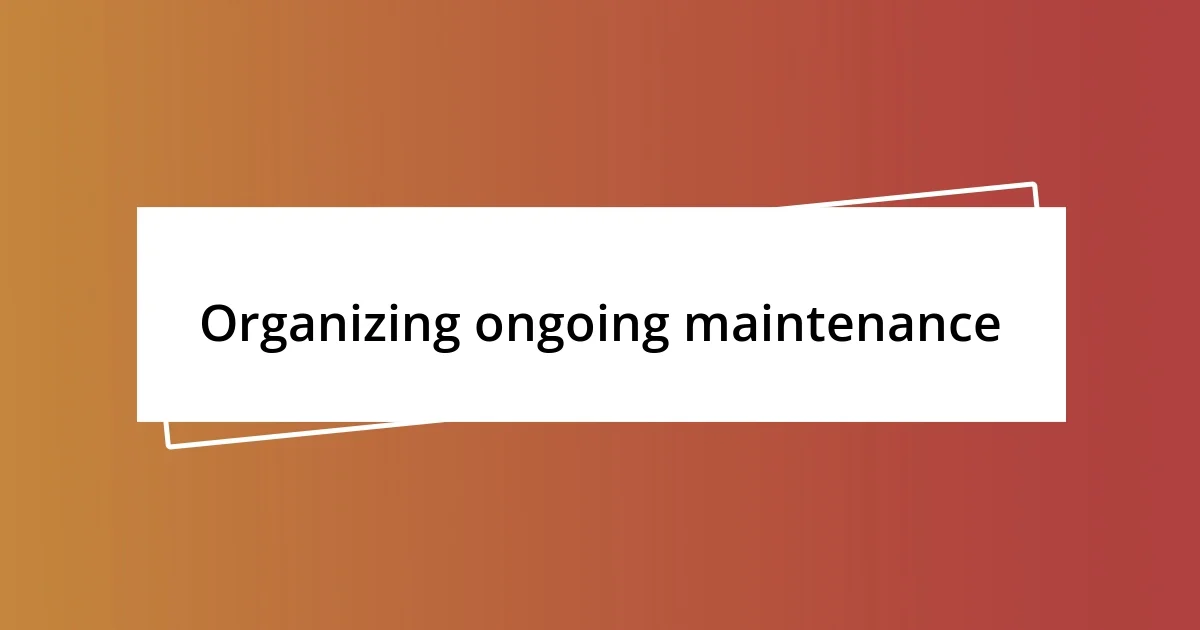
Organizing ongoing maintenance
Organizing ongoing maintenance became a key aspect of our community garden adventure. I recall one Saturday morning, coffee in hand, we gathered to discuss our roles. It was comforting to see everyone’s enthusiasm—some took on weeding duties, while others eagerly volunteered for watering schedules. It’s fascinating how sharing responsibilities transforms the maintenance into a collaborative effort. Who knew we could bond so much over pulling weeds and checking on seedlings?
One of the most memorable moments was when we established a simple calendar to track tasks and responsibilities. It wasn’t just a planning tool; it became a point of connection. I remember the joy of seeing folks post pictures of their contributions online. Suddenly, we’re not just maintaining a garden; we’re nurturing relationships. Doesn’t it feel rewarding when your hard work—whether watering or mulching—becomes a shared experience?
Over time, I noticed that assigning tasks based on personal skills led to more engaged volunteers. When we discovered that one member had a knack for composting, the rest of us were eager to learn. It struck me how these small discoveries could spark such enthusiasm. Isn’t it incredible how community gardens can not only grow plants but also talents and friendships? By continuously fostering a sense of ownership, we ensured that our garden thrived not just in the soil, but in the hearts of everyone involved.

Celebrating community achievements
Celebrating community achievements has been a highlight of my journey in the garden. I still remember the day we hosted our first harvest festival. The laughter, the sounds of clinking cups, and the aroma of freshly prepared dishes created an atmosphere of pure joy. Seeing neighbors gather together, sharing recipes and stories, made me realize just how far we had come as a community. Doesn’t it warm your heart to see people bond over homegrown produce?
Another proud moment was when we decided to donate a portion of our harvest to a local food bank. I can vividly recall the feeling of excitement mingled with purpose as we filled baskets with vibrant vegetables. Watching families pick them up, grateful for the fresh food, was incredibly fulfilling. It struck me that our garden was more than just a patch of earth; it was a source of nourishment and connection for those in need. Isn’t it amazing how a simple community garden can ripple out and touch lives?
As we celebrated these milestones, I became aware of how the garden ignited a newfound sense of pride among us. Just the other week, one volunteer spoke up during our monthly meeting, sharing how participating had reconnected her with her childhood memories of gardening with her grandparents. This shared nostalgia not only sparked inspiration but also deepened our commitment to the garden. These moments of shared accomplishments continuously remind me that our greatest achievement wasn’t just the crops we grew, but the connections we forged along the way. How rewarding is it to look back and see the impact we can make together?












